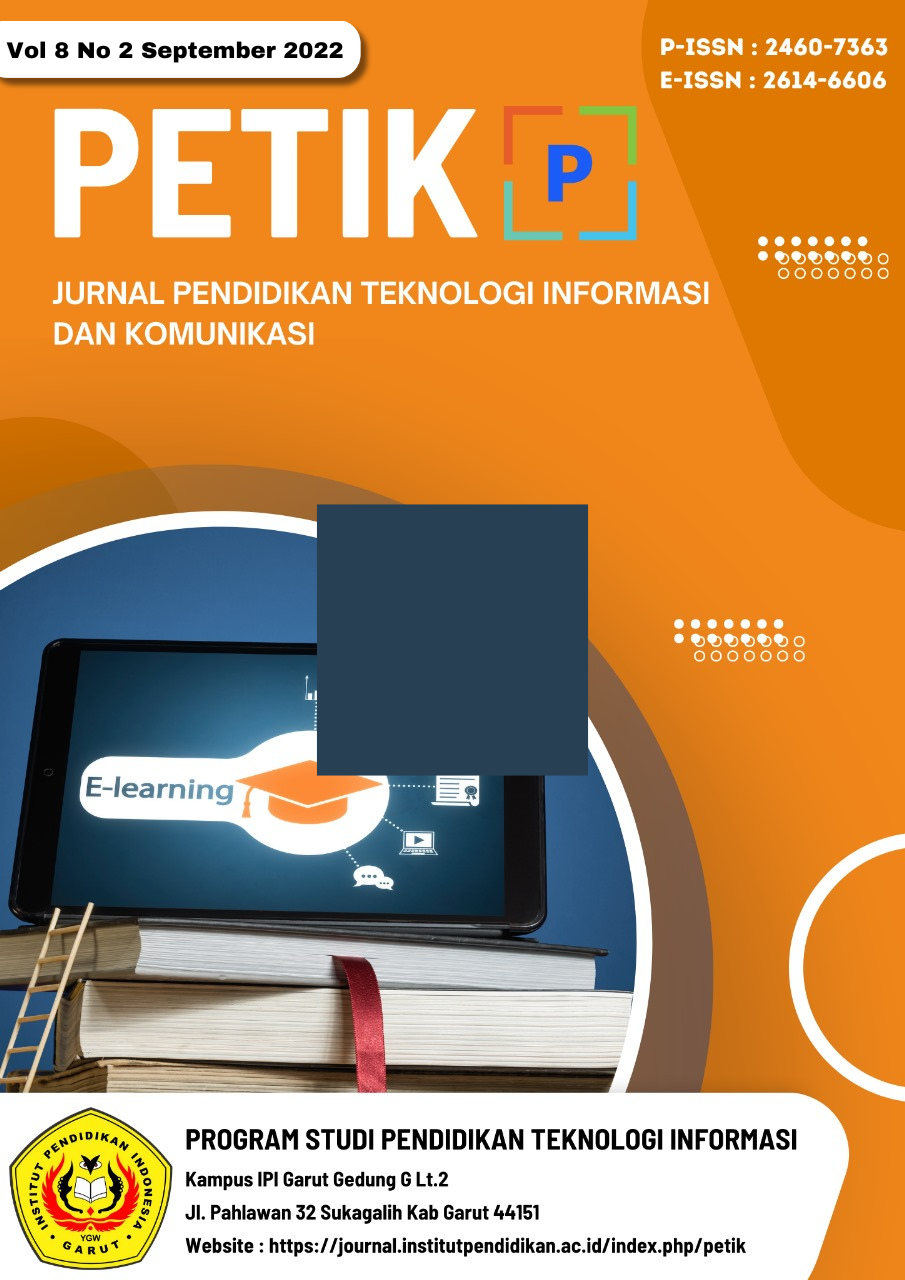Pengembangan E-Modul (Modul Digital) Berbasis Literasi Visual Pada Mata Kuliah Botani Phanerogamae
DOI:
https://doi.org/10.31980/petik.v8i2.1260Keywords:
Digital Module, Visual LiteracyAbstract
Abstrak — Keberadaan bahan ajar dalam suatu kegiatan pembelajaran memiliki banyak manfaat, antara lain membuat kegiatan belajar lebih menarik, memberikan kesempatan mahasiswa untuk belajar secara mandiri dan mengurangi ketergantungan terhadap kehadiran dosen, serta memberikan kemudahan kepada mahasiswa dalam mempelajari kompetensi yang harus dikuasainya. Pengembangan modul digital berbasis literasi visual menggunakan metode pengembangan atau Research and Development (R&D) yang menghasilkan sebuah produk berupa modul digital sedangkan model pengembangannya menggunakan model ADDIE yang terdiri dari lima tahapan yang meliputi analisis (analysis), desain (design), pengembangan (development), implementasi (implementation), dan evaluasi (evaluation). Pada tahap evaluasi digunakan instrumen penelitian terdiri dari lembar validasi angket praktikalitas. Lembar validasi bertujuan untuk melihat validitas produk yang dikembangkan. Lembar validasi diisi oleh dua orang ahli . Angket praktikalitas bertujuan untuk melihat tingkat kepraktisan produk modul digital. sementara subjek uji coba yang telah menggunakan modul digital yang dikembangkan yaitu mahasiswa tingkat dua program studi pendidikan biologi IPI Garut angkatan 2022 yang mengambil mata kuliah Botani Phanerogamae. Teknik analisa data menggunakan analisis deskriptif. Dari penyebaran angket didapat hasil bahwa e-modul sudah layak digunakan sebagai media pembelajaran dengan masing-masing persentase sebesar 84,7 % dari ahli media, 90,7 % dari ahli materi dan desain pembelajaran serta 85,7% dari respon mahasiswa. Sementara dari segi kepraktisan e-modul diperoleh nilai persentase sebesar 83,8% yang termasuk dalam kategori baik, artinya bahwa e-modul dikatakan praktis. Terakhir, untuk mengetahui keefektifan e-modul dilakukan pengukuran dengan melakukan penyebaran angket kepada mahasiswa, berdasarkan angket respon mahasiswa terhadap e-modul diperoleh nilai persentase sebesar 89,6 % dengan kategori baik artinya e-modul botani phanerogamae efektif digunakan sebagai media pembelajaran.
Keywords— Literasi Visual, Modul Digital
Abstract — The existence of teaching materials in a learning activity has many benefits, including making learning activities more interesting, providing opportunities for students to learn independently and reduce dependence on the presence of lecturers, and provide convenience to students in learning the competencies that must be mastered. Development of Visual Literacy -Based Digital Modules Using Development and Development (R&D). Methods that produce a product in the form of a digital module while the development model uses an ADDIE model which consists of five stages which includes analysis, design, development, implementation evaluation. At the evaluation phase the research instrument was used consisting of a practicality questionnaire validation sheet. Validation sheet aims to see the validity of the product developed. The validation sheet is filled by two experts. Practicality questionnaire aims to see the practicality level of digital module products. While the trial subjects that have used the developed digital module are second -level students of the Biology Education Study Program of IPI Garut class of 2022 who took the Botanical Panerogamae course. Data analysis techniques using descriptive analysis. From the distribution of the questionnaire, the results were found that e-modules were suitable for use as learning media with a percentage of 84.7 % of media experts, 90.7 % of the learning material and learning design experts and 85.7 % of student responses. While in terms of practicality e-module obtained a percentage value of 83.8% which is included in the good category, meaning that e-modules are said to be practical. Finally, to find out the effectiveness of e-modules, measurements are measured by distributing questionnaires to students, based on student response questionnaires to e-modules obtained a percentage value of 89.6 % with a good category means that the e-module of botanical panerogamae is effectively used as learning media.
Keywords — Digital Module, Visual Literacy
References
Paramita, “Pengaruh Learning Cycle 5E Terhadap Hasil Belajar IPA Kelas V SD Pupuan,” Mimb. PGSD UNDIKSA, vol. 4, no. 1, 2016.
Sukardi, Metodologi Penelitian Pendidikan Kompetensi Dan Praktiknya. Jakarta: Bumi Aksara, 2018.
U. H. Khairudin, Karmila Suryani, A.D. Trisno George Selvi, “Developing Educational Statistics Module by Using Problem-Based Learning (PBL) for the Students of the Faculty of Teacher Training and Education of Bung Hatta University, Padang, Indonesia,” Int. J. Eng. Technol., vol. 7, no. 4.9, pp. 220–225, 2018.
UNESCO, Leveraging Information and Communication Technologies to Achieve the Post-2015 Education Goal. Qingdao: United Nations Educational, Scientific and Cultural Organization, 2015.
A. Marquez, J., Villanueva, J., Solarte, Z., & Garcia, “IoT in Education: Integration of Objects with Virtual Academic Communities,” Adv. Intell. Syst. Comput., pp. 201–2012, 2016.
M. S. & T. M. Palmer, “Learning to See the Infinite: Measuring Visual Literacy Skills in a 1st year Seminar Course,” J. Scholarsh. Teach. Learn., vol. 15, no. 1, pp. 1–9, 2015.
Huang, “Empowering personalized learning with an interactive e-book learning system for elementaryschool students,” Educ. Tech Res. Dev., 2012.
M. Bozkurt, A., & Bozkaya, “Evaluation Criteria for Interactive E-Books for Open and Distance Learning,” Int. Rev. Res. Open Distrib. Learn., pp. 58–83, 2015.
A. Bamford, The Grammar within the world of Interactive Media. Education Researh Network Conference on Learning. 2001.
H. Jamieson, Visual Communivation, More Than Meets the Eye. United Kingdom: Intellect Books, 2007.
B. Wahyono, Peran dan Literasi Visual dalam Pembelajaran. 2014.
Warsita, Teknologi Pembelajaran, Landasan dan Aplikasinya. Jakarta: Rineka Cipta, 2008.
R. M. Branch, Instructional Design: The ADDIE Approach. New York: Springer, 2009.
A. Rikma, Sjarkawi, “Pengembangan E-Book Interaktif Untuk Pembelajaran Fisika SMP,” Tekno-Pedagogi Univ. Jambi, p. 15, 2015.







